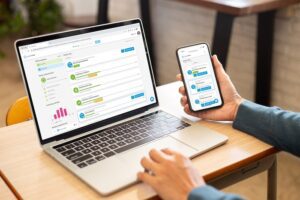The need for data literacy education in K-12 has never been higher. This article will provide an exhaustive look at the need for data literacy, examine existing efforts, and provide recommendations for educators.
Data Literacy in Context
In 2010, the world collected two zettabytes of data. To put that into perspective, If the average novel had a file size of two megabytes, two zettabytes would equal over two quadrillion books. That’s enough to comfortably fill the Library of Congress more than 52 billion times.
That figure sounds astronomical, and it is. But it doesn’t even scratch the surface. In 2022, the world collected an unprecedented 97 zettabytes of data, an increase of 4,750% from 2010.
In our data-driven society, the ability to comprehend, evaluate, and use data is indispensable. The Data Literacy Project discovered that 85% of executives believe data literacy will be as vital in the future as using a computer is today. In addition, Forbes predicts that data literacy will be the most in-demand skill over the next ten years, second only to digital literacy. And beyond the professional sphere, understanding how to interpret information is a crucial skill that allows us to make sense of the ever-changing digital world we live in.
Prepare your homeschooler for a data-driven future.
A common assumption is that young students are better equipped to navigate the complexities of data because they typically spend more time online than any other generation, but this isn’t the case. Students cannot learn data literacy automatically. They require opportunities to develop these key skills throughout their primary and secondary education.
Educators have the power to make this possible. By incorporating data literacy into school curriculums, using the right tools, and presenting information in an imaginative way, teachers have the unique opportunity to give their students one of the most valuable skills any individual can possess.
As experts in the industry, we at Quanthub have compiled a comprehensive guide to help you understand and teach data literacy in K-12. We’ll walk you through everything you need to know to integrate these key skills into your lessons throughout your students’ education.
But before we get into the details, let’s take a moment to understand what data literacy in K-12 means and how it can benefit students.
What is Data Literacy in K-12?
Data literacy in K-12 is all about teaching students to understand, assess, use, and create data in context.
In short, it’s a skill that empowers students to think critically, ask questions about the information they read, and use data to make informed decisions. Data literacy also encompasses the ability students possess to use data to their advantage, such as when discovering patterns, reaching their own conclusions, and justifying their viewpoints.
Why is Data Literacy Important?
 Data literacy is incredibly important for every student. When educators teach students how to interpret data, they provide them with the capability to sift through conflicting information, think critically about facts, and make informed, context-based decisions in every part of their personal and professional lives. And, at a time where conflicting information, breakthrough ideas, and AI-powered misinformation are commonplace, the importance of this ability cannot be understated.
Data literacy is incredibly important for every student. When educators teach students how to interpret data, they provide them with the capability to sift through conflicting information, think critically about facts, and make informed, context-based decisions in every part of their personal and professional lives. And, at a time where conflicting information, breakthrough ideas, and AI-powered misinformation are commonplace, the importance of this ability cannot be understated.
To elaborate on this, let’s briefly examine four key ways data literacy can help students navigate the complexities of the modern world.
1) Data literacy helps students reach their own conclusions
With millions of news articles posted online each day, it’s now more complicated than ever to separate authenticity from fake information. Data is everywhere, and students need the skills to interpret it.
Whether it’s evaluating facts and figures, assessing studies for validity, or understanding potential bias, students with strong data literacy skills can think critically about information and ask essential questions to reach their own data-backed conclusions.
2) Data literacy opens new career doors
In a study surveying over 2,000 managers and employees, Forrester Consulting found that 82% of leaders expect all employees to have basic data literacy. The same survey also discovered that data literacy is the most in-demand skill for entry-level positions.
Beyond meeting employer expectations, data literacy opens diverse career paths, from traditional sectors to emerging fields like data science. When educators give students these skills, they set them up for success in the increasingly data-focused professional landscape.
3) Data literacy teaches students to communicate
Just as data literacy empowers students to form their own arguments, it also gives them the tools they need to justify their ideas with evidence and present their insights as a cohesive story.
Whether it’s creating a graph to display findings or using statistics to back up an idea, data literacy empowers students to think critically and communicate effectively about the information they encounter.
 4) Data literacy teaches privacy and data management
4) Data literacy teaches privacy and data management
From personalized YouTube recommendations to tailored Google Search results, students are routinely bombarded with data based on their browsing habits. Many may enjoy tailored recommendations, but few know about the trail of trackable breadcrumbs they leave behind online.
Data literacy informs students about the risks of online activity. It teaches them how to exercise caution around websites and keep their personal information to themselves. It also tells them how websites and cookies monitor and use their browsing habits, allowing them to make informed decisions whenever they go online.
The Challenges of Data Literacy in Education
Despite the clear benefits of data literacy in K-12, teaching data literacy is still an undervalued skill in educational settings.
In fact, student data literacy has decreased over the long term. In a 2016 study, Stanford History Education Group discovered that 80% of middle school students couldn’t tell the difference between a paid ad and news content on a homepage.
There are still many hurdles to jump before we can begin to integrate data literacy into our classrooms fully. To elaborate on these issues, let’s explore two key challenges and the steps we must take to overcome them.
A Lack of Resources
In a 2020 article for The Harvard Business Review, Josh Bersin highlighted that schools often lack the resources to solve the data-literacy gap, with math lessons focusing on critical concepts such as calculus and algebra over applied teaching like statistics and probability.
This sentiment still rings true today. At the 2023 SXSW EDU conference, a panel of ed-tech investors outlined a need for more resources to help young students learn data literacy skills.
How can we overcome this challenge?
Attaining the resources to teach data literacy at scale is no overnight task. Doing so requires a concerted effort from states, school districts, organizations, and teachers.
While we still have a long way to go, efforts are already underway to allocate more resources to data literacy education in America. Many states are kickstarting their own initiatives to better encompass data literacy in K-12 education. One such initiative is Data Science for Everyone, a coalition of schools, individuals, and organizations, who are advocating for policy reform to encourage data literacy education in America’s schools.
As organizations and districts continue to push for more resources, teachers can fill the interim by incorporating data into their existing syllabus in meaningful ways. Using data and graphs to support information and providing opportunities for students to make inferences based on statistics nurtures critical thinking and provides a valuable space for students to gain essential data literacy skills.
A lack of teacher expertise
In a recent article on statistical and data literacy in K-12 STEM Education, researchers compiled the results of 42 studies and discovered that many teachers have knowledge gaps regarding crucial data and statistical literacy concepts.
Furthermore, a survey conducted in upper secondary schools in Switzerland discovered that while more than half of educators agreed they have data technology at their disposal, only one-third used the tools, and only one-quarter believed they could improve their teaching with data technology.
Whereas efforts are now underway to provide skills to future generations, educators seldom have the same training. Without this education, teachers are inclined to stick with the education methods with which they are most familiar.
How can we overcome this challenge?
In a study investigating the practices and beliefs of teachers in relation to data literacy, Megan Schramm-Possinger posits that a teacher’s ability to incorporate data literacy into their curricula is primarily defined by their own engagement with and understanding of data.
The key to supporting educators in comprehending data literacy is to expose them to essential concepts through courses, training, and professional development opportunities.
Teachers can also help to bridge this knowledge gap by engaging in their own studies outside of the classroom. Platforms like Qlik offer a range of courses that provide educators with the core skills they need to teach data literacy effectively. Software such as QuantHub also offers a unique way for teachers to teach themselves critical concepts in as little as five to ten minutes per day.
Who is Doing What in Data Literacy in K-12
Implementing data literacy into a school’s curriculum requires a combined, consistent effort from the top to the bottom. Organizations, schools, and educators must band together to create a cohesive curriculum that integrates data literacy throughout a student’s education.
While we still have a long way to go to achieve this goal, we have witnessed some exciting progress in recent years.
Acts and organizations
In 2023, Reps. Haley Stevens, D-Mich.; Don Beyer, D-Va.; Young Kim, R-Calif.; and Jim Baird, R-Ind. proposed the Data Science and Literacy Education Bill, an act that aims to improve and increase access to data science education. The bill is establishing a voluntary federal program, allowing K-12 schools to apply for funding for data science education.
The EDC’s Oceans of Data Institute (ODI) is also pushing for change in data literacy education. As part of the organization’s Innovation Pathway in Data and Civics (IDPC), the ODI is working with high school educators to develop guidebooks and courses that will help teachers create data-rich civics courses that teach their students about data and citizenship in tandem. The end goal is to equip students with practical data literacy skills that they can use to discover rewarding career paths.
Schools and teachers
Alongside the efforts of organizations, there has also been a marked increase in the number of state-level initiatives and school district programs to promote data literacy in education.
For example, Quanthub partnered with Alabama in 2022 to roll out a data literacy pilot program to 16 schools in the state. This small-scale initiative served to highlight both the exciting opportunities and inherent challenges of weaving data literacy into school curriculums.
As QuantHub’s platform adapts to each learner’s skills, teachers also received professional development credits for completing the training themselves. The program has been a success, helping bridge the data literacy gaps apparent in students and educators while providing a future roadmap for the implementation of data literacy curricula statewide. It his now available in public schools statewide.
After receiving strong support from Innovate Alabama and the workforce development community, the program was expanded to offer student internship connections with participating Alabama employers. State Superintendent Dr. Eric Mackey noted, “This initiative is not just about imparting knowledge; it’s about leveling the playing field for our students,”
Elsewhere, the EDCs Strengthening Data Literacy across the Curriculum project aims to promote data science and statistical thinking among high schools with large proportions of Black and Latino/a students. Eighteen participating teachers in 12 Massachusetts high schools tested the modules, which included projects such as investigating income equality in the U.S. The teachers’ efforts helped the initiative reach over 650 students.
Specific educators are also beginning to recognize the importance of data literacy in the 21st century. Sal Khan, the brain behind Khan Academy, recently adjusted his standard curriculum at his Lab School in California to emphasize data science. Students will now spend a year learning key data literacy topics.
The selections listed above reflect just a few of the exciting initiatives underway across the US.
Techniques to Teach Students to be Data Literate
There is no one-size-fits-all approach to data literacy. Teachers need to be creative and take a varied approach if they hope to get their class to think critically about data. To assist with this goal, we’ve compiled four key techniques educators can employ as they teach data literacy.
1) Start small
Some educators assume that data literacy is a skill students pick up later in their academic careers, but this doesn’t have to be the case.
In their landmark Pre-K-12 report, the American Statistical Association states that data literacy “cannot be honed to the level needed in the modern world through one high school course”. They then reinforce that “the best way to help people attain statistical literacy is to begin their statistics education in the elementary grades”.
Learning data literacy takes time, and teachers need to introduce vital concepts to children from a young age. Educators should consider allowing younger students to collect data from within the classroom, such as their peer’s hair or eye colors. The educator may then prompt the students to reveal what the data tells them. This fosters basic data analysis skills and encourages critical thinking about the information gathered.
2) Use accessible terminology
Data is a notoriously intimidating word, and the vast amount of complex jargon surrounding the term can make it a frightening subject for students. In talks with the Berkeley School of Information, Amit Bhattacharyya argues that we probably shouldn’t use complex data terminology unless we know our audience will understand it.
Using jargon in lessons causes two problems. First, it makes it harder for students to understand the applicability of data literacy in everyday life. Second, unnecessary jargon makes students lose motivation and disengage.
As a solution, Bhattacharyya recommends switching the jargon for accessible terminology that all students can understand. For example, a word like ‘standard deviation’ can be explained as the ‘measure of data spread’. Similarly, ‘inferential statistics’ can just as quickly be described as ‘conclusions we draw from data’.
The key here isn’t to remove jargon entirely but to elaborate on complex terminology in an accessible way. By doing so, educators can demystify data to become more understandable and enjoyable for every student.
 3) Personalize data with context and stories
3) Personalize data with context and stories
In their book Made to Stick: Why some ideas take hold and others come unstuck, authors Chip and Dan Heath argue that one of the most important ways to make information memorable is to present it as a story.
Whether it’s combining facts to form a cohesive narrative or creating an infographic to illustrate key statistics, teaching data literacy in authentic contexts improves recognition and helps students see the applicability of data literacy in the real world.
To incorporate this technique into your own curriculum, try to make your data literacy lessons mean something to your students.
Engage younger children with graphs of their favorite colors or animals to make the lesson more compelling. Alternatively, allow them to create their own data with something readily accessible in the classroom. For example, sorting a pack of M&M’s by color teaches data categorization and visualization in a real-life narrative context. This encourages engagement and makes the learning process more memorable.
For older students, provide a relevant, real-world question and allow the children to do their own research to answer the query. This approach offers a clear beginning, middle, and end, helping students to experience the power of data storytelling. It also provides an opportunity for the educator to teach students the importance of verifying and questioning their sources.
4) Encourage open communication and reward innovation
The benefits of critical thinking in classroom settings are well-known. But data literacy places a premium on the need to hone these skills.
Being data literate requires students to scrutinize information, question assertions, and discern whether a claim is true, false, or dubious. The demand for this ability also stretches beyond educational settings into students’ everyday lives, where they will need the acumen to reach their own conclusions on the data in front of them.
The key to fostering an environment in which students can think critically is to encourage open communication and recognize students who demonstrate innovative thinking. Students shouldn’t feel limited to a single way of viewing a data source. Instead, they should feel empowered to share their diverse perspectives and insights.
By listening to and proposing unique viewpoints, students will begin to comprehend how statistics can be interpreted in unique ways and, by extension, how they can lead individuals to different conclusions. This approach develops critical thinking skills, promotes curiosity, and gives students the acumen to think creatively about data problems in everyday life.
 Classroom Tools and Resources for Teaching Data Literacy
Classroom Tools and Resources for Teaching Data Literacy
As the importance of data literacy becomes increasingly apparent, many organizations are taking the necessary steps to create tools and resources that help teachers educate their students on key concepts. The list below provides links to a selection of tools that educators can use to augment their lessons.
- QuantHub leverages the latest in artificial intelligence technology to provide teachers and students with hyper-tailored, micro-learning courses on data literacy. The platform explains concepts, provides scenarios, and creates assessments to help students learn critical topics in as little as five to ten minutes. And, as QuantHub integrates seamlessly with dozens of different lessons, subjects, and curricula, it’s easy for teachers to incorporate the software’s capabilities into their existing lesson plans as a bell ringer or exit slip.
- Tableau Public allows students to create interactive and shareable graphics. This is an excellent way to help students visualize data and understand how they can display their own findings to be more effective and memorable.
- Tools such as Poll Everywhere and DirectPoll allow you to collect responses from your students in the classroom. You can then generate graphs, charts, and graphics to display the results, allowing students to visualize how raw data can transform into accessible information.
- Gapminder provides interactive visualizations of global statistics and development data. To incorporate this into your classroom, consider providing students with a statistic before asking them to think critically and draw interpretations.
- The Federal Reserve Bank of St.Louis provides a number of K-12 lessons that teach key concepts in data literacy to teachers.
- Tools like Piktochart and Infogram make it easy to create intuitive, compelling infographics. These programs are an excellent way to teach students the power of data storytelling.
- The University of Michigan’s Supporting Librarians in Adding Data Literacy Skills to Information Literacy Instruction is a dedicated resource designed to help librarians understand and implement data learning practices within schools.
- Safety Smart Online uses the Lion King’s Timon and Pumba to give kindergarteners through to third-grade-aged children simple, engaging lessons on the importance of safeguarding their personal information on the web. In an increasingly online world, resources like these are a vital way to get younger students to think about big data and the decisions they make online.
The Future of Data Literacy in Education
With the world on track to collect an astonishing 181 zettabytes of data in 2025—almost double the amount we collected in 2017—it’s clear the growing demand for data literacy isn’t slowing down anytime soon.
The ubiquity of social media, the prevalence of online tracking, and the rapid growth of the Internet of Things (IoT) mean students must be equipped with the tools they need to understand, interpret, and use data in varied contexts.
Another pressing concern is the rapid development of A.I. technology. While artificial intelligence is an indispensable tool for dozens of industries, large language models also make it easier than ever before to spread misinformation. As these technologies continue their meteoric rise, the ability to ask questions and sift through data will become even more crucial.
Data is set to become America’s most in-demand career path over the next decade. The U.S Bureau of Labor Statistics predicts data-focused jobs will grow by 36% between 2021 and 2031.
Are US schools prepared for this? In the current educational climate, they aren’t. Despite the increasing importance of literacy in the face of our data-driven future, there is a noticeable gap in its integration into the K-12 education system.
But promising signs do offer a glimpse into a brighter future. A Datacamp report discovered that 88% of respondents endorsed data literacy as a foundational skill for the future, and a further 90% agreed on the urgent need for schools and universities to add data literacy training into their curriculum.
As society wakes up to the vital importance of data literacy, we can expect to see more legislative acts and initiatives, such as the recently proposed Data Science and Literacy Education Bill.
These acts will continue to drive change throughout the country, providing schools with the resources they need to deliver data literacy to students more effectively.
In the meanwhile, teachers must remain proactive, strive to understand critical concepts, and use the tools at their disposal to provide the skills students need to navigate the increasing complexities of our digital world.
A Data Literate Generation is an Achievable Goal
While the current outlook on data literacy in U.S. schools is fraught with challenges, the positive momentum generated by teachers, policymakers, organizations, and communities offers hope that the educational system can evolve to meet the demands of our data-driven future.
We still have a long way to go to equip our K-12 students for the data-focused road ahead, but individual educators have more power than they realize to drive change.
That change starts with you.
By interweaving data literacy into your lessons, fostering open discussion, and making complex ideas accessible, you can provide students with one of the most indispensable skills they will ever possess.
If you’re looking to set your students up for data literacy success, QuantHub has your back. Our solution leverages the latest in A.I. technology to help educators teach data skills to their students alongside existing curricula.
To learn more about integrating data literacy into your lessons—or find out how our revolutionary program can help you understand and teach data literacy—schedule an appointment with our expert team today.